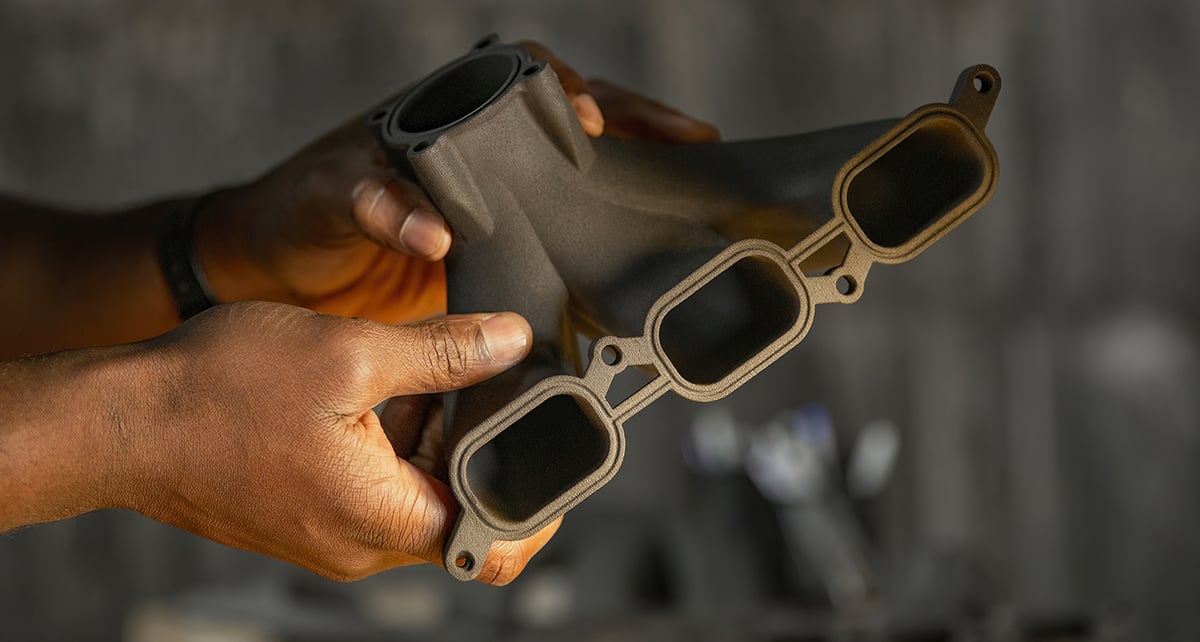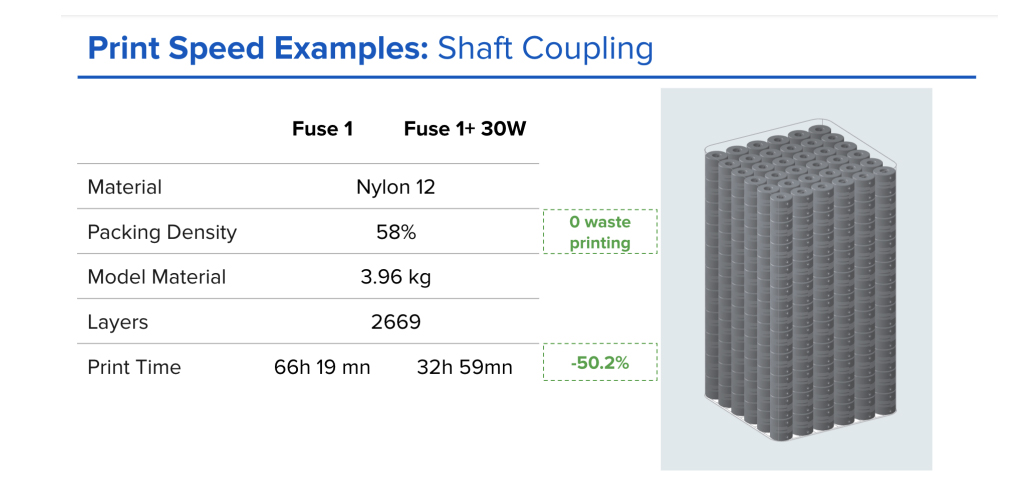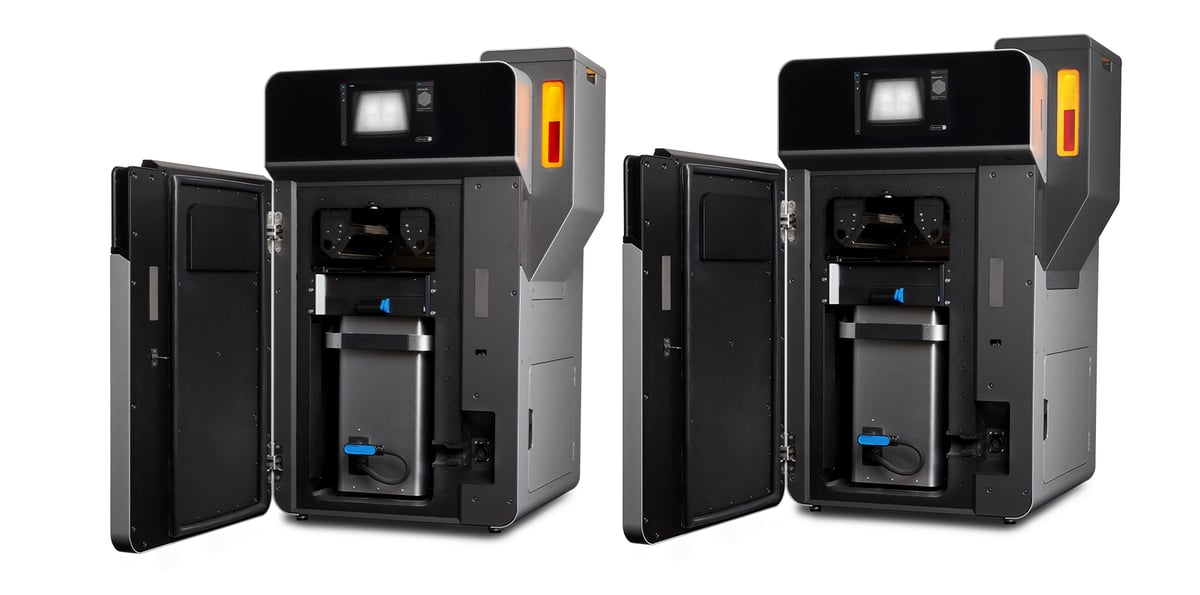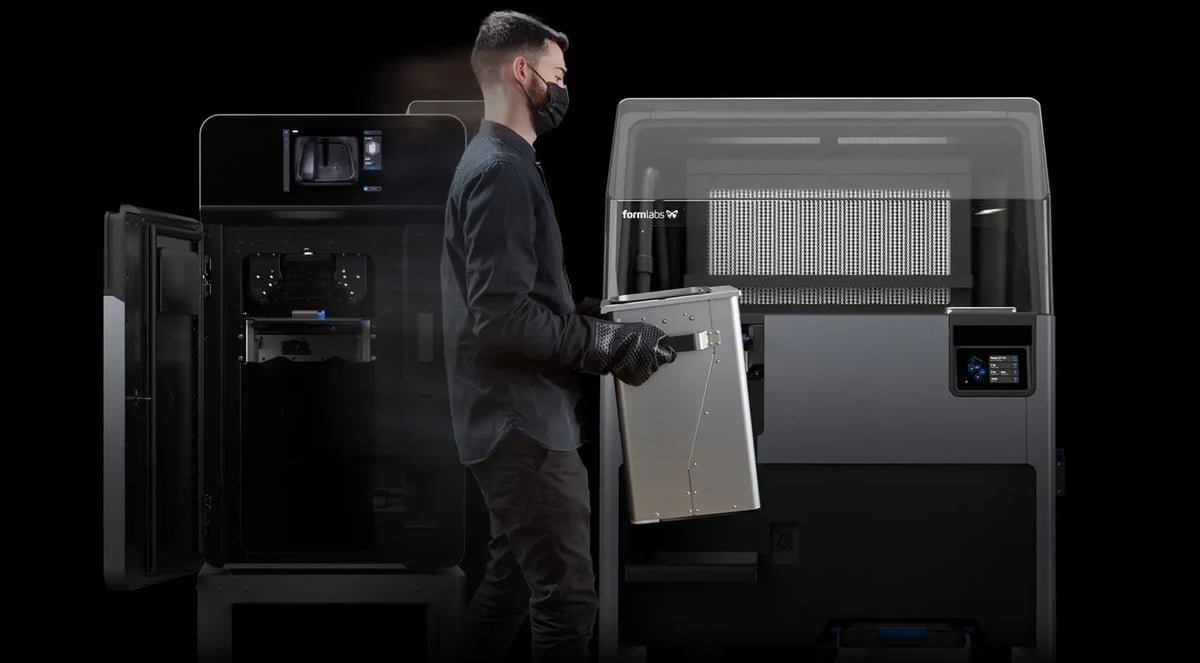Formlabs, best known for its range of versatile and dependable resin printers, just launched a new version of its selective laser sintering (SLS) 3D printer that can make professional-grade parts from polymer powders twice as fast as its previous version. The Fuse 1+ 30W is a reengineered version of the Fuse 1 that Formlabs introduced in January 2021 to put SLS technology within reach of more small and mid-size businesses. The new upgrades don’t make every print situation twice as fast, but tripling the power of the laser, upgrading the material handling mechanisms, and boosting the ability to tightly pack parts into a single print job, will boost your overall productivity, Formlabs promises.
At a fraction of the cost of most SLS machines on the market, the Fuse 1 quickly became a favorite of small manufacturers, automakers, and shop floors of all varieties for its ability to produce lightweight rigid Nylon parts strong enough to withstand repeated impact, making it ideal for replacement and spare alternatives to metal parts, high-impact equipment, factory tools, and functional prototypes.

Now, after several years of raw materials shortages, supply-chain disruption, and factory shut-downs, manufacturers are searching for ways to bring end-use and spare part production and prototyping in-house whether for stop-gap options, validation stages, or customization applications.
The Fuse 1+ 30W not only boasts faster production times but the ability to work with more durable and stronger material, such as the favored carbon-fiber infused Nylon 11 (also called PA 11).
Formlabs says the Fuse 1+ 30W integrates new components to improve throughput and material performance, while still operating as a compact, contained, and affordable ecosystem. Let’s take a closer look.
Twice as Fast?
Whether printing a single prototype or running the printer non-stop for part and tool production, speed is a top priority in any industry. To reduce overall print time, Formlabs added a more powerful laser (30 Watt from a previous 10 Watt) and an updated laser scanning system with scan speeds of up to 12.5 meters per second. There’s also an upgraded packing algorithm so you can print multiple design versions in one job instead of several jobs.
In the example below, Formlabs says the Fuse 1+ 30W can complete a packed print bed of parts in half the time it took the previous Fuse 1 version. Printing more than 100 shaft couplings in 32 hours is not fast by industrial SLS standards but for a more affordable benchtop machine, it speaks for itself when compared to ordering from a factory overseas or even across town.

New Fuse 1+ 30W features include:
- A 30-watt laser (Fuse 1 had a 10-watt laser)
- Scan speeds up to 12.5 meters per second
- New Nylon 11CF (carbon fiber) powder option
- Optional nitrogen supply to boost print quality, powder recyclability
- Lower-waste printing due to high packing density, powder recyclability
- New powder hopper agitator for smooth material delivery
“Large manufacturers that might already ues SLS 3D printing can decentralize their 3D printing operation without duplicating the cost of their traditional SLS systems, giving more engineers, designers, and technicians access to industrial quality SLS. With that broader access, new applications in replacement parts, fixtures, jigs, tooling, and more are made possible across the company,” Formlabs says.
Formlabs Fuse 1+ 30W Tech Specs
- Print Engine: Selective Laser Sintering
- Build Volume: 165 × 165 × 300 mm
- Price: $27,500
- Laser: Ytterbium Fiber 30W
- Layer Thickness: 110 microns
- Material Refresh Rate: 30% (new material)
- Startup Time: 60 minutes
- Connectivity: Ethernet, Wi-Fi, USB 2.0
- Printer Dimensions: 64.5 × 68.5 × 107 cm
- Weight: 120 kg (without build chamber or powder)
- Power Requirements: 230 VAC EU, 7.5 A; 120 VAC US, 15 A
- Print Preparation: PreForm Desktop Software
- File Type: STL or OBJ, FORM file output

Formlabs SLS Materials
The Fuse 1 updates make it possible to manage an industrial material like Nylon 11 infused with carbon fiber. You’re limited to using Formlabs materials but proprietary formulations of Nylon powder are common throughout the additive manufacturing industry. Printer manufacturers fine-tuned the material to their machines, and Formlabs is no different.
The Fuse 1+ 30W is compatible with:
- Nylon 12
- Nylon 12 GF (glassed filled)
- Nylon 11
- Nylon 11CF (carbon-fiber filled)
Formlabs says the Fuse 1+ 30W integrates two new features that unlock more advanced powder possibilities. A new optional nitrogen purge feature creates an inert gas environment during the print process, eliminating unwanted oxygen from the sintering environment. When printed in this inert environment, parts exhibit less brittleness and better ductility, enhancing their suitability as end-use components, especially in rugged environments, such as automotive or aerospace.

Formlabs isn’t offering a compatible nitrogen generator, since they are widely available on the market, but it does recommend some models. The nitrogen purge also enables a more efficient sintering process for Nylon 11 powder and Nylon 11 CF powder by better preserving unsintered powder from oxidation, allowing users to reuse more of it in the next printing cycle. This leads to higher powder recyclability, and when combined with an optimal packing density, Formlabs says they can create a zero-waste printing workflow. Without the nitrogen purge, Nylon 11 and Nylon 11 CF Powders have a 50% refresh rate, meaning 50% recycled and 50% fresh powder must be used to create each new cartridge. With nitrogen purge, this improves to 30% with both materials.
Formlabs Nylon 11 CF powder requires a more sophisticated powder handling system to ensure powder flow during the printing process. The Fuse 1+ 30W engineering team designed a solution that includes a new agitator within the powder hopper to create a consistent, smooth delivery of material into the build chamber and opening up possibilities for future high-performance materials.
License: The text of "Formlabs’ New Printer Delivers Parts Twice as Fast" by All3DP Pro is licensed under a Creative Commons Attribution 4.0 International License.
